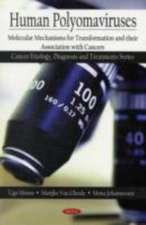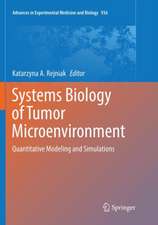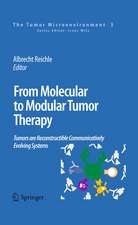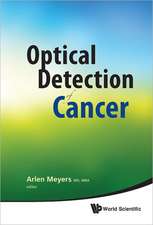Evolution-adjusted Tumor Pathophysiology:: The Novel Language of Tumor Biology
Editat de Albrecht Reichleen Limba Engleză Hardback – 11 iul 2013
| Toate formatele și edițiile | Preț | Express |
|---|---|---|
| Paperback (1) | 1103.39 lei 43-57 zile | |
| SPRINGER NETHERLANDS – 8 aug 2015 | 1103.39 lei 43-57 zile | |
| Hardback (1) | 1118.59 lei 43-57 zile | |
| SPRINGER NETHERLANDS – 11 iul 2013 | 1118.59 lei 43-57 zile |
Preț: 1118.59 lei
Preț vechi: 1177.46 lei
-5% Nou
Puncte Express: 1678
Preț estimativ în valută:
214.06€ • 222.22$ • 178.50£
214.06€ • 222.22$ • 178.50£
Carte tipărită la comandă
Livrare economică 24 martie-07 aprilie
Preluare comenzi: 021 569.72.76
Specificații
ISBN-13: 9789400768659
ISBN-10: 9400768656
Pagini: 464
Ilustrații: X, 453 p.
Dimensiuni: 155 x 235 x 30 mm
Greutate: 1.02 kg
Ediția:2013
Editura: SPRINGER NETHERLANDS
Colecția Springer
Locul publicării:Dordrecht, Netherlands
ISBN-10: 9400768656
Pagini: 464
Ilustrații: X, 453 p.
Dimensiuni: 155 x 235 x 30 mm
Greutate: 1.02 kg
Ediția:2013
Editura: SPRINGER NETHERLANDS
Colecția Springer
Locul publicării:Dordrecht, Netherlands
Public țintă
Professional/practitionerCuprins
Preface.-I Introduction.-Communication ─ evolution ─ pathophysiology: An endogenous conjunction ─Instead of an introduction.-II Combined modularized therapies for metastatic tumors: Pointing to central problems of communication among ‘systems participators’ in tumors.- Applied systems biology for the control of metastatic cancer: Therapeutic top-down strategy for targeting the tumors’ normativity.- Targeting the proangiogenic network in angiosarcomas: Biomodulatory therapy.- Long-term results of combined modularized, immune-modulatory, angiostatic, and antiinflammatory therapy in systemically pre-treated multi-systems Langerhans cell histiocytosis.- Redirecting and modulating rationalizations of tumor-immanent normative functions in castration-resistant prostate ancer.-III Social engineering: Biomodulation, either endogenously initiated or by implementation of non-normative boundary conditions.- Non-hierarchically organized operations in malignancies: Stromal dysfunction induces hematopoetic malignancies.- Biomodulatory therapy approaches in renal clear cell carcinoma: A perspective.- Proteome analysis identified the PPARc ligand 15d-PGJ2 as a novel drug inhibiting melanoma progression and interfering with tumor-stroma interaction.IV The tumors’ normativity: Reconstructing and operationalizing starting points for an evolution theory.- The philosophical quest of a cancer cell: Redefining existentialism.- The tumor’s normativity: Normative structures, action norms and decision maxims as therapeutic targets for tumor therapy.- Criticizable claims for the validity of communication acts in biological systems: Therapeutic implications in cancer.-V Evolution theory.- Evolution theory: Its practical relevance for understanding tumor development and specifying tumor therapy.- Modularity, subjectivity, intersubjectivity and normativity: Clinically applicable operative benchmarks.- Turningupside down the mode of science to emphasize and harness the impact of environmental communicative events. VI From genome- or organ-centric to rationalization-centric systematization of tumors.- Purposive-rational tumor therapy: Exploiting the tumor’s ‘living world’ for diversifying, specifying and personalizing tumor therapy.- Including rationalizations of tumor-associated normative notions in pathophysiologic considerations: Communication-theoretical implications.-VII Reconstruction of tumor-immanent normative functions, structures and decision maxims (hubs).- Bridging a diagnostic and therapeutic gap: Selecting, assessing and categorizing tumor-associated normative notions.- Personalizing tumor pathophysiology by diagnosing developmental problems in tumors with imaging techniques.- Biologic memory: Induction by metronomically administered combined modularized therapy.- VIII The tool of rationalizations constituting tumor-associated normative notions: The non-genomic counterpart of the tumor genome and therefore, an important therapeutic target for diversifying palliative care.- Diversifying and specifying palliative care for patients with metastatic cancer by therapeutic implementation of non-normative boundary conditions.- Targeting a hallmark of cancer: Simultaneous inflammation and tumor control for palliative care in metastatic cancer.-IX Novel clinical and pharmaceutical technology for bioengineering tumor response.- Combined modularized tumor therapy ─ tumor biology ─ and prognostic factors: Bioengineering tumor response.-X Objectifying the systems objects’ subjectivity in biological systems: A novel reification of the scientific picture about the ‘objective’ world.- The systems objects’ subjectivity as scientific object. Index.
Textul de pe ultima copertă
Combined modularized therapies for metastatic cancer are pointing to central problems of communication among ‘systems participators’. A communication theory explains 'social engineering', endogenously induced or by implementing non-normative boundary conditions. Evolution-adjusted tumor pathophysiology is borne by an evolution theory, which contrasts narrative evolution histories. The tool of rationalizations constituting the tumor's normativity (inflammation, immune response etc.) represents the non-genomic counterpart of the tumor genome and should be additionally assessed during tumor staging. Evolution-adjusted tumor pathophysiology allows implementing applied systems biology, a novel clinical and pharmaceutical technology for bioengineering tumor response and personalizing tumor therapy. Combined modularized therapy, evolution-adjusted tumor pathophysiology, and ‘universal’ biomarkers concertedly address genetically based tumor heterogeneity.
Caracteristici
Applied systems biology Personalizing tumor therapy with novel methodological approaches Drafting the non-genomic counterpart of the genome: Rationalizations constituting tumor-associated normative notions (angiogenesis, inflammation, immune response etc.) Reconstructing and operationalizing starting points for an evolution theory Evolution-adjusted tumor pathophysiology as novel clinical and pharmaceutical technology for bioengineering tumor response




















